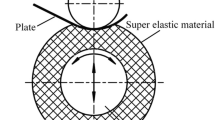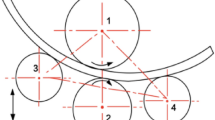Abstract
The four-roll bending machine is large-scale bending equipment. It has a wide range of applications in various engineering industries. Rebound is an unavoidable phenomenon in the process of profile roll forming, which directly affects the processing accuracy of the profile. In order to improve the forming quality of four-roll bending machine bending profiles after rebound, the forming process flow is first analyzed, and according to the relationship between its four-roll bending and side roll displacement, the establishment of a mathematical model of the side roll displacement in the state of no rebound; secondly, the Bouhêlier rebound equation is combined with the mathematical equation of side roll displacement to obtain the theoretical forming radius-side roll displacement relationship equation and finite element simulation to verify; then, through the prototype of the actual roll forming, the measured roll forming data through MATLAB processing, through the Power function fitting to get the actual forming radius-side roll displacement relationship and generate functional equations, and with the theoretical forming radius-side roll displacement of the relationship between the equation combined with the final elasticity of the compensation value of the equation; finally, the elastic compensation equation is verified by the prototype machine, and the average error between the actual radius and the expected radius is only 0.65%, which is within the allowable range of profile bending error. The results show that the compensation method meets the requirements of profile roll bending, and compared with the traditional compensation formula, its roll bending accuracy is significantly improved, in line with the expected requirements.
























Similar content being viewed by others
References
Jian L, Juqing C, Jiujun Y (2015) Roll bending process and roll displacement calculation model of four-roll plate rolling machine. Yi Chong Technol 3(1):5
Kai W, Fulin C, Zhaoyang X et al (2011) Four roller plate bending rolls rolled around in the process of design and the establishment of mathematical model. J Forg Equip Manuf Tech 46(48):6
Zhiqiang Z, Jianli S, Jianhua F et al (2014) Research status of sheet metal bending and rolling forming process. J Plast Eng 21(01):1–6
Sen L, Fulin C, Bin L (2011) Calculation of side roll displacement in four-roll plate rolling machine. Forg Stamp Technol 36(06):76–79
Yuxun C (1998) Principle and method of bending rebound control for sheet and profile. National Defense Industry Press, Bei**g, pp 79–104
Shining M (1958) Bending machine and straightening machine. China Machine Press, Bei**g, pp 1–15
Tongxi Y, Liangchi Z (1992) Plastic bending theory and its application. Science press, Bei**g, pp 9–19
Hongcai T (2019) Research on control technology of roll bending with variable curvature of profiles. Yanshan University
Gan W, Wagoner RH (2004) Die design method for sheet spring-back. Int J Mech Sci 46(7):1097–1113
Jenn-Terng G, Gary LK (2001) A new model for spring-back pre-diction in which the Bauschinger effect is considered. Int J Mech Sci 43(8):1813–1832
Kim H, Nargundkar N, Altan T (2007) Prediction of bend al-lowance and springback in air bending. J Manuf Sci Eng 129(2):342–351
Bouhêlier C (1982) Formage des tôles fortes, Techniques ingénieurs, B7630 pp 5 19 (in French)
Sheng** F (1989) New root finding formula and new discriminant method for cubic equation of one yuan. J Hainan Norm Univ 2(2):91
Morse L, Sharif Khodaei Z, Aliabadi MH (2019) A dual boundary element based implicit differentiation method for determining stress intensity factor sensitivities for plate bending problems. Eng Anal Bound Elem 106:412–426
Yunsheng MAO, Lei HOU, Chengfang WANG (2003) Theoretical calculation and automatic control model of plate roll forming. China Shipbuild 02:76–82
Shen** W, Beiying L (2006) Nonlinear simulation in ABAQUS. Mach Build Autom 35(2):20–22
Yan W, Zhu XQ, Jiefei Hu et al (2018) Study on numerical simulation of continuous rolling and bending forming process of four-roll plate winder. J Syst Simul 30(5):1772–1780
Yan W, Jiefei H, Guanghui X et al (2016) Mechanism and experimental analysis of four-roll prebending and continuous roll bending. J Plast Eng 23(04):69–75
Leacock AG, McCracken D, Brown D et al (2012) Numerical simulation of the four roll bending process. Mater Manuf Process 27(4):370–376
Fu Z, Tian X, Chen W et al (2013) Analytical modeling and numerical simulation for three-roll bending forming of sheet metal. Int J Adv Manuf Techn 69(5–8):1639–1647
Wu K, Sun Y, Cao CP et al (2017) On simulation analysis of plate forming and deformation compensation technology of the side roll for four-roll plate bending machine. Proc Eng 207:1617–1622
Kun S (2017) Research on key technology of high-precision four-roller plate rolling. Nan**g University of Science and Technology
Yan W, **min C, Guanghui X et al (2017) Study and experimental analysis of springback in three-roll roll forming process. J Plast Eng 24(05):44–51
Author information
Authors and Affiliations
Corresponding author
Ethics declarations
Conflict of interests
The authors declare that they have no conflict of interest.
Additional information
Technical Editor: Diego Carou Porto.
Publisher's Note
Springer Nature remains neutral with regard to jurisdictional claims in published maps and institutional affiliations.
Appendix
Appendix
1.1 Solve RT

1.2 Solve β

1.3 Solve Y

1.4 Solve3Polynomial

Rights and permissions
Springer Nature or its licensor (e.g. a society or other partner) holds exclusive rights to this article under a publishing agreement with the author(s) or other rightsholder(s); author self-archiving of the accepted manuscript version of this article is solely governed by the terms of such publishing agreement and applicable law.
About this article
Cite this article
Jiang, S., **g, Y., Liu, H. et al. Theoretical and experimental analysis of springback compensation for four-roll roll forming. J Braz. Soc. Mech. Sci. Eng. 46, 446 (2024). https://doi.org/10.1007/s40430-024-05026-2
Received:
Accepted:
Published:
DOI: https://doi.org/10.1007/s40430-024-05026-2




